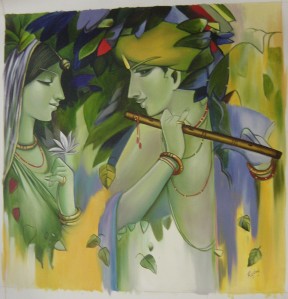
…
Krishna denotes all manifestations of Bhagavān Viṣṇu — the carefree and effortlessly self-manifest personality who is the fountainhead of all-pervasive consciousness. But Nāma Kaumudī finishes its definition by stating that the word krishna specifically refers to someone who was “raised on Yaśodā’s breast.” So, although krishna refers to consciousness itself (brahman) and although it refers to Viṣṇu as the source of all consciousness (paramātmā) and the epitome of all personality (bhagavān), in the ultimate focus this word denotes a very specific form of Bhagavān: the one who is raised by the loving breast-milk of the queen of Vraja, Śrī Yaśodā Devī. Ultimately, the word krishna refers to the famous Gopa of Vṛndāvana whom the Bhāgavata Purāṇa lauds as the fountainhead of all Viṣṇus, who are themselves the fountainheads of all consciousness, which is the very substance of reality itself.
The most literal, basic meaning of krish- is simply, “pull.” Krishna- means “existence.” It has this meaning because existence is the tangible coagulation of consciousness, a structure pulled into place by consciousness’ gravity. The primary trait of Krishna is that he “pulls,” like a magnet, like gravity.
![]()
Krishna has already spoken of himself several times as the highest deva, one with Brahman, thus very much invoking the spirit of monotheism. Historically, there is a very strong emphasis on monotheism in the Abrahamic traditions. We hear the very subtle and powerful enunciation of monotheism in the Jewish Shema: “Hear, O Israel: the Lord our God is one Lord: and thou shalt love the Lord thy God with all thy heart, with all thy soul, and with all thy might.” (Deuteronomy 6:4–5) This proclamation has had an enormous impact on Christianity and Islam as well. Monotheism is often considered by pious people and scholars in the West to be the acme of religious understanding. But no other religious notion has had a more pernicious consequence in creating bigotry and fanaticism than monotheism. Monotheism has resulted everywhere in “my-theism,” leading to warfare against other people’s religious forms. No one would say, “There is one God, and it is not my God but yours.” The late Nobel laureate Octavio Paz said, “We owe to monotheism many marvelous things, from cathedrals to mosques. But we also owe to it hatred and oppression. The roots of the worst sins of Western civilization—the Crusades, colonialism, totalitarianism—can be traced to the monotheistic mindset…. For a pagan, it was rather absurd that one people and one faith could monopolize the truth.” –
Krishna’s monotheism is not of an exclusive sort that says “You must not worship any other god.” On the contrary, it is very inclusive. Of course, depending on the degree of understanding and the quality of one’s inner nature, a person may be inclined to worship this or that deva. But all the devas are included in Krishna and he blesses them all. “But whatever form any devotee with shraddhā (faith, respect) wishes to worship, I make that shraddhā firm and steady. Disciplined by that shraddhā, the devotees who worship those forms obtain their desires. In truth I myself give these to the devotees.” (7.21–22) It may be mentioned in passing that this inclusive aspect of the Hindu religion was much emphasized by Vivekananda, the great Hindu monk of India, in his speech at the Parliament of Religions in Chicago in 1893, and he quoted these shlokas from the Gita. It should also be mentioned with some sadness that in some Hindu quarters there is a tendency, often in reaction to exclusivist biblical religions, to make Krishna a sectarian God, in competition with other gods, but the Gita is nothing if not inclusive.
Krishna, as the Unmanifest, Unborn, and Imperishable, is not and cannot be revealed to all. Most of us are caught in the delusion of opposite—us and them, believers and infidels, good and evil, and the like—which arises from desire and hatred, attraction and repulsion; and this illusion arises right at birth, as Krishna says. (7.27) This could lead to a notion similar to “original sin” in Christianity, resulting in a deep sense of personal guilt. But it is possible to be free of this delusion of opposites and come to Krishna realizing that all action is Brahman. (7.29 and also 4.24) Those who know that Krishna is the supreme being (adhibhūta), the highest deva (adhidaiva), and the greatest yajna (adhiyajna) remember him even at the time of death and are united with him.
From The Bhagavad Gita by Ravi Ravindra © 2017 by Ravi Ravindra. Reprinted in arrangement with Shambhala Publications, Inc. Boulder, CO. www.shambhala.com
